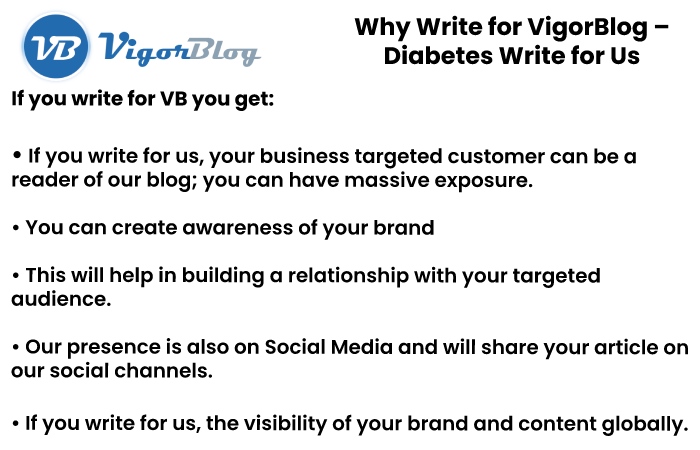Diabetes Write for Us
 Diabetes is a condition that develops when your blood glucose, often known as blood sugar, is excessively high. Blood glucose is your primary energy source from the foods you consume. Insulin, a hormone produced by the pancreas, aids in transporting glucose from food into your cells for use as energy. Sometimes your body does not have enough—or any—insulin, or it may not use insulin effectively. Glucose thus remains in your circulation rather than reaching your cells.
Diabetes is a condition that develops when your blood glucose, often known as blood sugar, is excessively high. Blood glucose is your primary energy source from the foods you consume. Insulin, a hormone produced by the pancreas, aids in transporting glucose from food into your cells for use as energy. Sometimes your body does not have enough—or any—insulin, or it may not use insulin effectively. Glucose thus remains in your circulation rather than reaching your cells.
Too much glucose in your blood might lead to health concerns over time. Although there is no cure for
it, you can take steps to control it and stay healthy.
Types Of Diabetes
it is classified into three types: type 1, 2, and gestational.
Type 1 diabetes can occur at any age, but it is most common in children and adolescents. With type 1 diabetes, your body generates very little or no insulin, requiring daily injections to control blood glucose levels.
Adults are more likely to develop type 2 diabetes, which accounts for almost 90% of all diabetes cases. When you suffer from 2 diabetes, your body does not properly utilize the insulin it generates. A healthy lifestyle, including increased physical activity and a nutritious diet, is the cornerstone of type 2 diabetes management. However, most persons with type 2 diabetes will eventually require oral medications or insulin to control their blood glucose levels. Find out more.
Gestational diabetes (GDM) is a kind of diabetes that causes high blood glucose levels during pregnancy and is linked to difficulties for both the mother and the child. GDM typically goes away after pregnancy, but women who have it and their children are at a higher risk of getting type 2 diabetes later in life.
Symptoms
Your blood sugar level determines diabetes symptoms. Symptoms of type 1 diabetes tend to appear quickly and are more severe. Some people may not have symptoms, especially if they have prediabetes, gestational diabetes, or type 2 diabetes.
Type 1 diabetes and type 2 diabetic symptoms include:
- Urinating often.
- Feeling more thirsty than usual.
- Losing weight without trying.
- Ketones can be found in urine. Ketones are produced as a byproduct of muscle and fat breakdown when inadequate insulin is available.
- Feeling tired and weak.
- Feeling irritable or experiencing other mood swings.
- Having blurry vision.
- Dealing with slow-healing sores.
- Infections such as gum, skin, and vaginal infections are common.
How to Update Your Articles?
To Write for Us, you can email us at contact@vigorblog.com
Why Write for Us – Diabetes Write for Us

Search Terms Related to Diabetes Write for Us
Endocrine diseases
High blood sugar levels
Beta-cells
Insulin
Autoimmune response
Insulin replacement therapy
Anti-diabetic medications
Metformin
Semaglutide
Polydipsia
Weight loss
Headache
Fatigue
Search Terms for Diabetes Write for Us
submit an article
guest posting guidelines
become a guest blogger
become an author
submit post
guest posts wanted
suggest a post
guest post
write for us
looking for guest posts
guest posts wanted
contributor guidelines
contributing writer
writers wanted
Guidelines of the Article – Diabetes Write for Us
 You can send your article to contact@vigorblog.com
You can send your article to contact@vigorblog.com
Related Pages:
